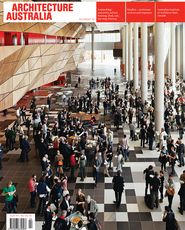Shaneen Fantin considers the recent report Understanding Architectural Education in Australasia.
Michael J. Ostwald and Anthony Williams’ report Understanding Architectural Education in Australasia brings two competing questions to my mind, as the director of a small architecture and research practice in north Queensland: What does a small, regionally based but innovative practice seek in an architecture graduate as a potential employee? What does the architecture profession, and its new models of practice, need from architectural education to vitalize and maintain its future?
The two questions have different aims and require different answers, but Ostwald and Williams demonstrate that architecture schools in Australia are required to provide for both and are struggling to meet these needs. Professional practice requires certain technical skills in graduates – software competencies, basic construction knowledge, writing and verbal communication skills – which are complemented by proficient and creative problem solving. However, the future of architectural education should not be restrained by the functional requirements of mainstream architectural practice. Architectural education needs to support specialization, flexibility and innovation in design and research at an undergraduate level in order to fertilize the profession for growth.
Understanding Architectural Education in Australasia is groundbreaking because it is the first comprehensive analysis of architectural education in twenty schools across three countries: Australia, New Zealand and Papua New Guinea. Over two volumes it provides detailed analysis of the needs of architectural schools, academic staff and students, the profession and the community. The content is extensive and thorough. It is presented in graphs, tables and pie charts and supported by introductory and explanatory text. The report makes seventeen recommendations for improving undergraduate architectural education.
Architectural education is fraught with conflicting needs. Ostwald and Williams identify four primary areas of tension: the ever-expanding professional accreditation requirements developed by the Institute and the Architects Accreditation Council of Australia (AACA), the needs of existing and emerging models of practice, student needs and community perception, and the demands of universities on architecture schools.
The authors identify the gradual reduction in resources and staff-to-student ratios over the past twenty years as one of the greatest crises in architectural education. This is in part a result of insufficient funding that fails to provide comprehensively for studio-based and computer-intensive learning environments. Architecture schools are losing studio environments and small teaching-to-student ratios.
My experiences of teaching in four different architecture schools in Australia align with the authors’ concerns. Teaching in architecture is extraordinarily demanding. Schools are often strapped for resources and space, and teaching staff are stretched to their limits. The demands of teaching and research are all-encompassing. Ostwald and Williams note that academic staff have less time to engage with practice-based activities and recommend an alternative academic/practitioner employment model which enables academics to seek leave specifically related to practice.
Ostwald and Williams also lament an emerging homogenization across the architecture schools in the Australasia region, and identify a greater need for differentiation, specialization and self-direction among schools. They state, “Within reasonable limits, schools must be able to shape their teaching and learning styles, to make decisions about their curriculum focus, study area content and educational philosophy. The architectural profession explicitly supports the need for differentiation between programs but, in practice, accreditation requirements, along with a range of other issues including the underfunding of student places, mitigate against diversity” (Volume 2, p.26).
The Institute and AACA need to accept that the practice and teaching of architecture is no longer limited to design, documentation and management of projects in the traditional sense. New models of practice contain people with specialist knowledge and skills that require a commitment to ongoing research. Within some practices, much time is spent researching and developing a speciality. Ostwald and Williams highlight the fact that the current professional assessment model does not easily accommodate students emerging with specialist skills. Recommendation 3 suggests that the competencies for graduate programs in architecture schools be differentiated to the competencies for architectural practice to provide prior to registration. This transfers some of the current workload and responsibility for architectural education to the architectural profession and peak bodies.
Ostwald and Williams raise a number of other concerns and recommendations regarding assessment of design studios and group work in architecture schools, the use of online support systems, and the need for an architectural education journal and/or forum. For readers interested in detail, Volume 1 is full of fascinating data on student profiles and salaries, academic staff profiles, and the teaching and learning environment over the past twenty years.
As a practitioner with a research background, but relatively limited teaching experience, I cannot comment comprehensively on the limitations of Ostwald and Williams’ research. However, there were a number of items either beyond the scope of the research or not attended to in the book that are opportunities for further work and analysis: The scope of the research does not extend to analysing postgraduate architectural education. Given how valuable the findings of this book are, an equivalent process should be committed to this topic.
The findings are not compared with any from European, American, Asian or African architecture schools. If such research exists, it would be fascinating to establish similarities and differences.
What is a reasonable staged implementation for the seventeen recommendations? This is obviously the next step in the research if it is to have effective outcomes.
Understanding Architectural Education in Australasia makes a critical contribution to architectural education research in Australia, New Zealand and PNG. The outcomes of this research should be reviewed closely and considered by architecture schools, the Institute and the AACA. Ideally it will be the first round of a cyclical analysis and assessment of architectural education to ensure that the needs of students, academia, the profession and the community are more synthesized and less conflicted.
Dr Shaneen Fantin practises and researches architecture and many things related to it. She is the director of People Oriented Design in Cairns.















